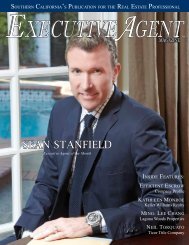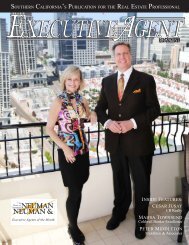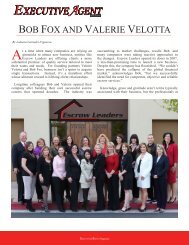Gail Anderson - Executive Agent Magazine
Gail Anderson - Executive Agent Magazine
Gail Anderson - Executive Agent Magazine
- No tags were found...
Create successful ePaper yourself
Turn your PDF publications into a flip-book with our unique Google optimized e-Paper software.
S<br />
urprisingly, opinion polls revealed a sharp contrast<br />
between the voters who had actually watched<br />
the debates on TV versus those who had merely<br />
listened to them on the radio. While radio listeners<br />
clearly thought that Nixon had won the first debate,<br />
television viewers were captivated by Kennedy’s smile,<br />
charm and athletic appearance.<br />
The majority of viewers interviewed reported that<br />
Nixon’s five-o’clock shadow and darting eyes made him<br />
appear sinister and far less presidential than Senator<br />
Kennedy. The television cameras underscored the<br />
significance of nonverbal communication and forever<br />
changed the political landscape.<br />
Are You Missing Your Prospect’s “Buy Signals”<br />
Think about the tremendous advantage you would have<br />
as a baseball manager if you knew the opposing team’s<br />
signals and were able to anticipate their game plan. For<br />
example, suppose you knew in advance that the other<br />
team was planning to steal second base. Obviously, your<br />
team would have a competitive edge because you would<br />
be able to adjust your strategy as necessary. Likewise,<br />
as a professional salesperson, you would be wise to<br />
monitor your prospect’s body language and adjust your<br />
presentation accordingly. By reading your prospect’s<br />
gestures you will minimize perceived sales pressure and<br />
know when it’s appropriate to close the sale.<br />
In 1872, Charles Darwin published the book “The<br />
expressions in Man and Animals” and launched the<br />
modern study of nonverbal communication. Essentially,<br />
body language is a mixture of movement, posture and<br />
tone of voice. The good news about this subject is<br />
that your subconscious mind already understands the<br />
meaning of every gesture, posture and voice inflection.<br />
The bad news is, without the proper training you are<br />
unable to consciously apply this information during your<br />
client appointments.<br />
E A<br />
Actions Speak Louder<br />
Than Words<br />
By Jon Boe<br />
language, it’s important to be mindful of your own<br />
gestures and keep them positive. Remember to unfold<br />
your arms, uncross your legs, nod your head in agreement<br />
and smile frequently.<br />
The study of nonverbal communication is similar to<br />
learning a foreign language in that it requires time and<br />
effort to achieve fluency. Acquiring this important skill<br />
will allow you to communicate more effectively, read<br />
your prospect like a book and close more sales in less<br />
time.<br />
Build Trust and Rapport<br />
Matching and mirroring your prospect’s body<br />
language gestures is unconscious mimicry. It is a way<br />
of subconsciously telling another that you like them<br />
and agree with them. The next time you are at a social<br />
event, notice how many people are subconsciously<br />
matching one another. Likewise, when people disagree<br />
they subconsciously mismatch their body language<br />
gestures. The psychological principle behind matching<br />
and mirroring is that people want to do business with<br />
salespeople that they believe are similar to them.<br />
You can build trust and rapport by deliberately, but<br />
subtly, matching your prospect’s body language in the<br />
first fifteen minutes of the appointment. For example,<br />
if you notice that your prospect is crossing their arms,<br />
subtly cross your arms to match them. After you believe<br />
you have developed trust and rapport, verify it by seeing<br />
if your prospect will match you. Uncross your arms<br />
and see if your prospect will match and mirror you as<br />
you move into a more open posture. If you notice your<br />
prospect subconsciously matching your body language<br />
gestures, congratulations, this indicates that you have<br />
developed trust and rapport. Conversely, if you notice<br />
your prospect mismatching your body language gestures,<br />
you know trust and rapport has not been established and<br />
you need to continue matching and mirroring them.<br />
Top salespeople and the most successful managers<br />
recognize the importance of nonverbal communication<br />
in the selling process and have learned to “listen with<br />
their eyes.” They understand that one of the easiest and<br />
most effective ways to close sales is to be aware of their<br />
prospect’s “buy signals.”<br />
In addition to monitoring your prospect’s body<br />
Body Language Quiz<br />
If you’re a manager, consider using this quiz at<br />
your next training meeting to assess your sales team’s<br />
current level of expertise. When sitting in on a sales<br />
appointment with your sales rep, be sure to incorporate<br />
nonverbal communications feedback in your critique.<br />
28<br />
<strong>Executive</strong><strong>Agent</strong> <strong>Magazine</strong>
















